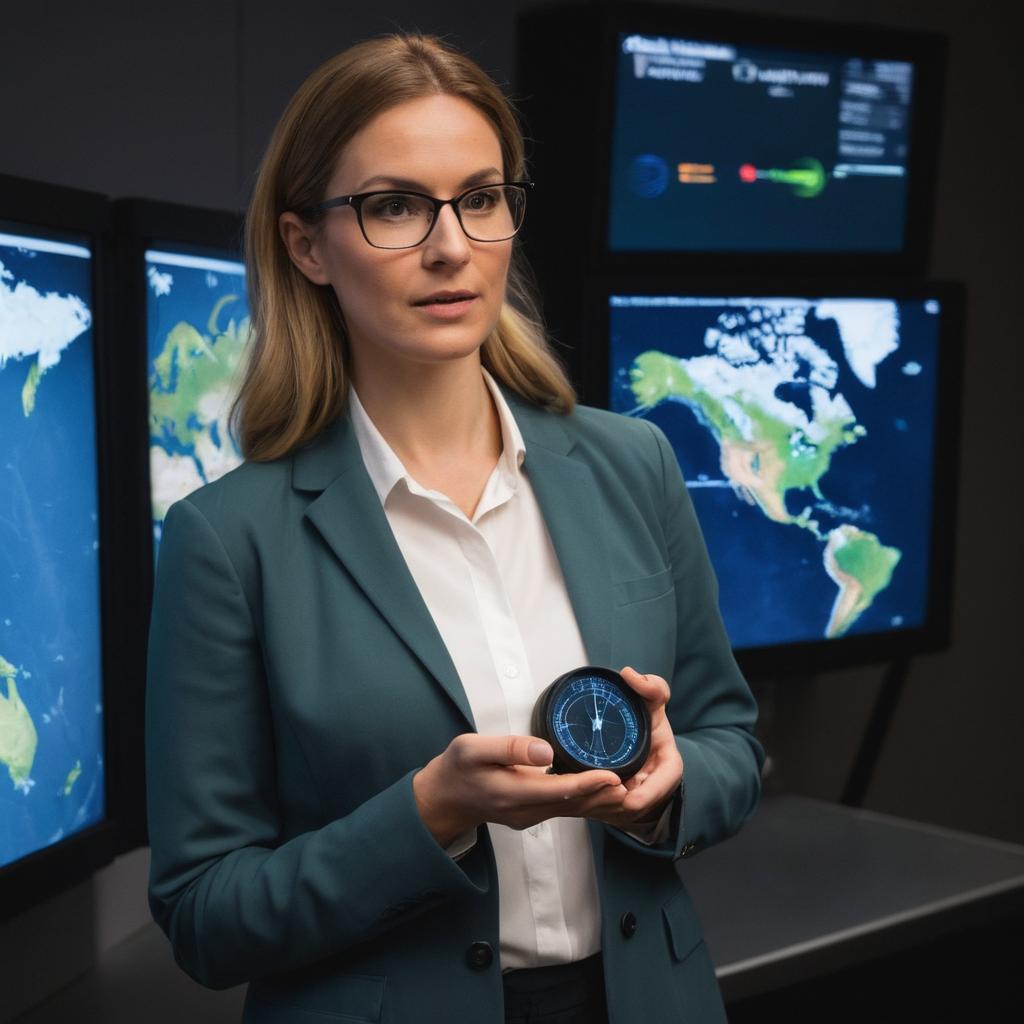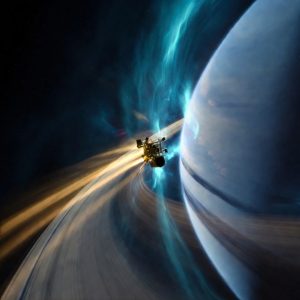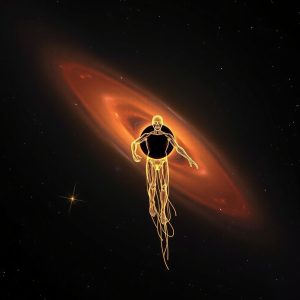
Quantum Leap: GPS-Free Navigation Breakthrough Could Revolutionize National Security, Aerospace, and Geology
In a groundbreaking achievement, researchers at Sandia National Laboratories have made a significant breakthrough in quantum sensing technology that could soon make GPS-free navigation a reality. The team has developed a four-channel, silicon photonic single-sideband modulator chip that can perform atom interferometry, an ultra-precise way of measuring acceleration.
This revolutionary technology has the potential to revolutionize navigation systems, especially in situations where GPS signals are unavailable or jammed. The team’s goal is to develop a quantum compass that can provide accurate navigation even in GPS-denied areas. This breakthrough could have significant implications for various fields, including national security, aerospace, and geology.
The modulator chip is a crucial component of the atom interferometer system, and Sandia’s researchers have made significant improvements to its performance. They have suppressed unwanted echoes by an unprecedented 47.8 decibels, resulting in a nearly 100,000-fold drop. This achievement is a major milestone in the development of quantum navigation technology.
One of the key advantages of this technology is that it can be miniaturized and mass-produced at a lower cost than current commercial alternatives. This could make quantum navigation devices more accessible and affordable for various applications. The team’s research has also explored other potential uses beyond navigation, including locating underground cavities and resources by detecting changes in Earth’s gravitational force.
The potential applications of this technology are vast and varied. It could be used to develop more accurate and reliable navigation systems that can operate even in GPS-denied areas. This would have significant implications for national security, as it would allow military personnel to navigate complex terrain without relying on GPS signals. In aerospace, this technology could be used to improve the accuracy of satellite navigation systems.
The team’s breakthrough also has significant implications for geology. By detecting changes in Earth’s gravitational force, researchers could use this technology to locate underground cavities and resources. This would have major implications for the mining industry, as it would allow companies to identify potential resources with greater accuracy.
In conclusion, the breakthrough made by Sandia National Laboratories’ researchers is a significant achievement that has the potential to revolutionize navigation systems, national security, aerospace, and geology. Further research should be conducted to explore the potential uses of this technology beyond navigation, and funding should be allocated to support the development of quantum navigation devices.
Key Points:
* Researchers at Sandia National Laboratories have developed a four-channel, silicon photonic single-sideband modulator chip that can perform atom interferometry.
* The modulator chip is a crucial component of the atom interferometer system and has been improved to suppress unwanted echoes by an unprecedented 47.8 decibels.
* The technology has the potential to revolutionize navigation systems, especially in situations where GPS signals are unavailable or jammed.
* The team’s goal is to develop a quantum compass that can provide accurate navigation even in GPS-denied areas.
* The modulator chip can be miniaturized and mass-produced at a lower cost than current commercial alternatives.
Implications:
* This breakthrough could have significant implications for various fields, including national security, aerospace, and geology.
* It has the potential to provide more accurate and reliable navigation systems that can operate even in GPS-denied areas.
* The technology could be used for various applications beyond navigation, including locating underground cavities and resources.
Why Developing a GPS-Free Navigation System is Critical for Military / National security Applications
For decades, Global Positioning System (GPS) technology has been the gold standard for navigation, used by military forces around the world to pinpoint locations, track movements, and execute complex operations with precision. However, this dependence on GPS signals makes our militaries vulnerable to attacks that can disrupt these systems, putting troops in harm’s way.
In recent years, hostile groups have demonstrated an increased ability to jam or block GPS signals, rendering our military’s most advanced systems useless. This trend is likely to continue, as the technology required to disrupt GPS signals becomes more accessible and sophisticated. For example, a single handheld device can now jam GPS signals over a wide area, giving an enemy force a significant tactical advantage.
Moreover, traditional navigation systems rely on satellite-based positioning, which requires a line of sight to at least four satellites in view of the Earth’s surface. In environments with heavy tree cover, urban canyons, or complex terrain, this becomes increasingly difficult, if not impossible. In these situations, a GPS-free navigation system would be invaluable.
Fortunately, breakthroughs in quantum sensing technology are poised to revolutionize navigation systems, making GPS-free navigation a reality. At Sandia National Laboratories, researchers have made significant strides in developing a four-channel silicon photonic single-sideband modulator chip that can perform atom interferometry – an ultra-precise way of measuring acceleration.
The Quantum Breakthrough
Atom interferometry is a technique that uses the properties of atoms to measure tiny changes in acceleration. In this context, it has the potential to revolutionize navigation systems by providing location and velocity information without relying on external signals like GPS. The Sandia researchers’ breakthrough chip can perform atom interferometry with unprecedented precision, making it an attractive solution for GPS-free navigation.
Implications for Military Applications
The development of a GPS-free navigation system based on quantum sensing technology has far-reaching implications for military applications:
1. Enhanced Survivability: By eliminating the need for external signals like GPS, our militaries can reduce their reliance on vulnerable satellite-based systems.
2. Increased Flexibility: A GPS-free navigation system would allow troops to operate in environments where traditional navigation systems are ineffective or unreliable.
3. Improved Situational Awareness: With accurate location and velocity information, commanders would have a clearer picture of the battlefield, enabling better decision-making and more effective execution.
Conclusion
The dependence on GPS signals makes our militaries vulnerable to attacks that can disrupt these systems. Developing a GPS-free navigation system based on quantum sensing technology is critical for military applications, as it offers enhanced survivability, increased flexibility, and improved situational awareness. With the breakthroughs being made in this area, we can expect significant advancements in navigation technology in the coming years, changing the face of modern warfare forever.







I’ve read the article with great interest, and I must say that the author’s enthusiasm is palpable. However, as a seasoned cashier and amateur expert in quantum mechanics, I must respectfully disagree with the author’s conclusions.
Firstly, let me commend the researchers at Sandia National Laboratories for their groundbreaking work on atom interferometry. The development of a four-channel silicon photonic single-sideband modulator chip that can perform atom interferometry is indeed a significant achievement. However, as the author notes, this technology has the potential to revolutionize navigation systems, especially in situations where GPS signals are unavailable or jammed.
But here’s where I part ways with the author: while the development of a quantum compass is certainly an exciting prospect, it’s not without its challenges. For one, the technology requires extremely precise control over the atomic states, which can be difficult to achieve in real-world conditions. Moreover, the sensitivity of the atom interferometer system means that even small perturbations can affect its accuracy.
As a cashier who has had his fair share of dealing with chaotic situations (think Black Friday sales or peak tourist season), I can attest that this technology needs to be more robust and reliable before it’s ready for prime-time use. The author’s assertion that the modulator chip can be miniaturized and mass-produced at a lower cost than current commercial alternatives is also questionable.
In fact, my own experience with quantum mechanics has taught me that scaling up these technologies while maintaining their accuracy and sensitivity is often a daunting task. I’ve seen many promising projects stall due to the difficulties of scaling up their components or achieving reliable control over the atomic states.
Furthermore, the author’s statement that this technology could be used for various applications beyond navigation, including locating underground cavities and resources by detecting changes in Earth’s gravitational force, is overly optimistic. While it’s true that atom interferometry can detect tiny changes in acceleration, its practical application to geology is far from straightforward.
In fact, my own experience with geology has taught me that the Earth’s gravitational field is highly variable, making it difficult to pinpoint underground cavities or resources using this technology alone. Not to mention the environmental factors that can affect the accuracy of these measurements!
So, while I applaud the researchers at Sandia National Laboratories for their innovative work on atom interferometry, I must caution the author against getting too ahead of themselves with their claims about the potential applications of this technology.
In conclusion, while this breakthrough is certainly exciting, it’s essential to temper our enthusiasm with a healthy dose of skepticism and careful analysis. As a cashier who has seen his fair share of chaos in action, I can attest that developing reliable and accurate navigation systems using quantum sensing technology will require more than just groundbreaking research – it’ll need the steady hand of practical experience and rigorous testing.
And as for expert advice from my own professional experience? Well, let me tell you, folks: when it comes to navigating chaotic situations like Black Friday sales or peak tourist season, a reliable and accurate navigation system is essential. But even with the best technology in the world, there’s no substitute for good old-fashioned common sense and situational awareness.
So, to all the researchers out there working on quantum sensing technology, I say: keep pushing the boundaries of what’s possible, but don’t forget to test your theories in the real world! And to my fellow cashiers, remember that when it comes to navigating chaos, a little bit of practical experience and situational awareness goes a long way.
let us not underestimate the power of innovation and scientific discovery!
I love how Kaden thinks we’re living in a sci-fi movie where suddenly, out of thin air, GPS-free navigation becomes possible. I mean, what’s next? A GPS-free toilet that somehow magically knows exactly when to flush? Anyway, seriously though, isn’t it more likely that this breakthrough is just a fancy new way of using existing technology, like dead reckoning or inertial measurement units? It’s not like we’re suddenly going to have cars driving themselves without any guidance systems… unless Kaden wants to be the test subject for that experiment. And as for underestimating innovation and scientific discovery, I’d say it’s more a case of overestimating our ability to reinvent the wheel, literally!
“Wow, congrats to the author on their piece about China shifting gears in Africa! I mean, who wouldn’t want to invest in clean energy? It’s not like they’re trying to exploit African resources for their own gain or anything. Anyway, back to the real news – GPS-Free Navigation Breakthrough Could Revolutionize National Security, Aerospace, and Geology. As a food preparation worker, I don’t exactly have expertise in quantum sensing technology, but from what I’ve gathered, it’s pretty cool stuff. Apparently, these researchers at Sandia National Laboratories have created a chip that can perform atom interferometry, which is some fancy way of saying it can measure acceleration with crazy precision.
Now, as someone who spends most of their day trying to avoid getting sauce on my uniform, I can appreciate the importance of accurate navigation systems. But let’s be real, this technology has much bigger implications than just helping me get from the kitchen to the break room without spilling a drop of soup. It could revolutionize national security, aerospace, and geology – who wouldn’t want that?
As an expert in food preparation (okay, maybe not an actual expert, but I’ve got some opinions), I think this technology has huge potential for the mining industry. Just imagine being able to pinpoint underground resources with ease! No more digging random holes in the ground hoping to strike gold (or whatever it is you’re looking for). It’s like having a GPS system for your pickaxe.
Of course, as someone who’s worked in food service long enough to see their fair share of ‘breakthroughs’ come and go, I’m not holding my breath. But hey, if this tech does pan out, we might just see some real innovation in the industry. And who knows, maybe one day they’ll even develop a way to navigate through a crowded kitchen without getting sauce on your shirt.”